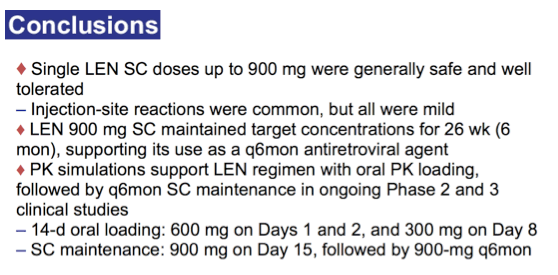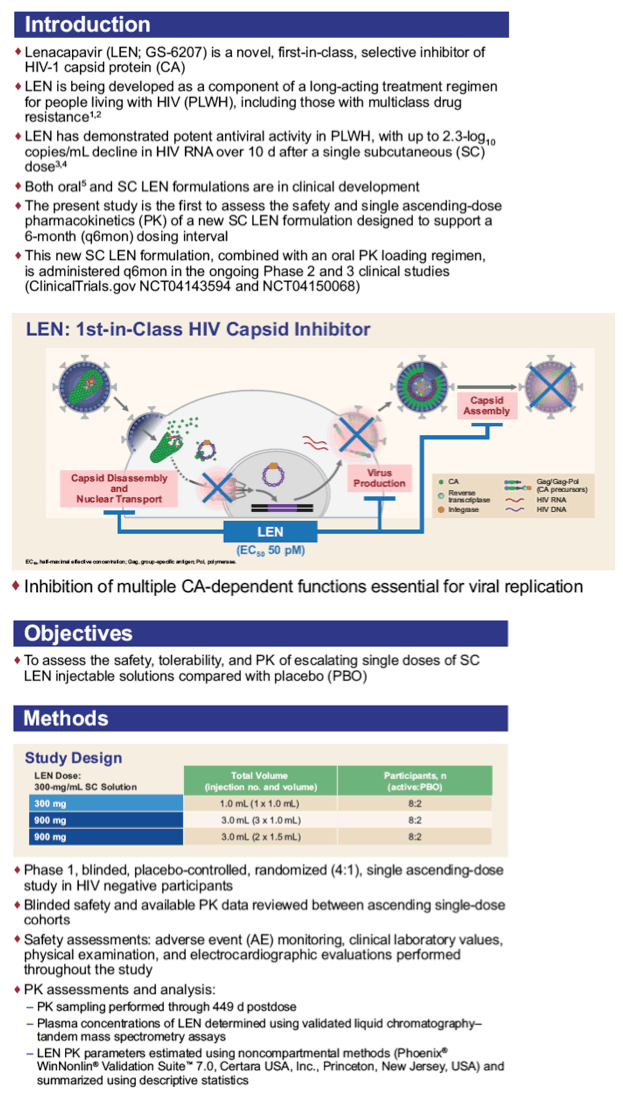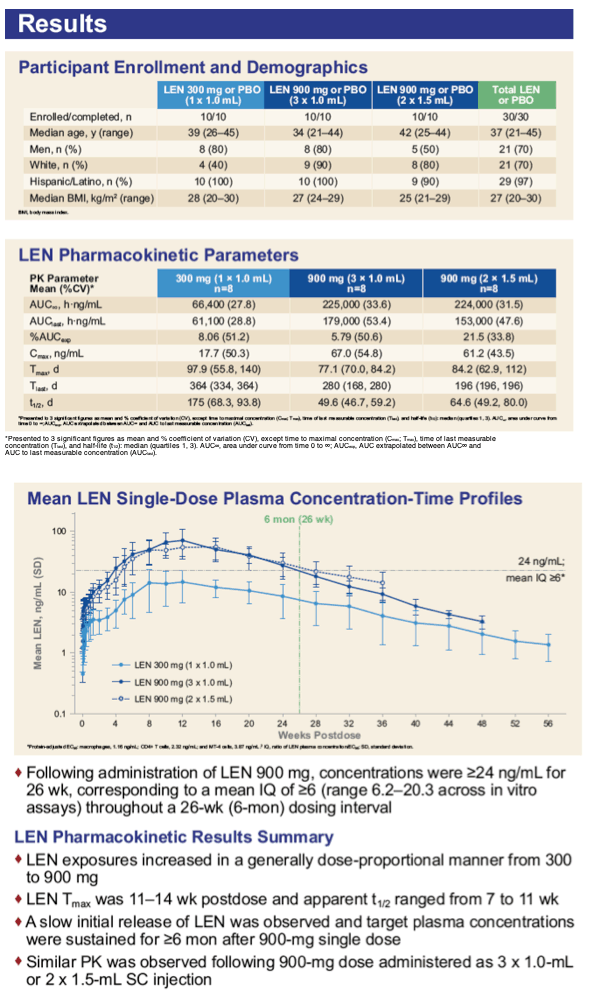 |
 |
 |
| |
Lenacapavir Sustained Delivery Formulation Supports 6-Month Dosing Interval
|
| |
| |
AIDS 2020: 23rd International AIDS Conference Virtual, 6-10 July 2020
Rebecca Begley, Justin Lutz, Martin Rhee, Hadas Dvory-Sobol, Anna Chiu, Steve K. West, Jessica Corpus, John Ling, Polina German - Gilead Sciences, Inc., Foster City, California, USA
Reported by Jules Levin

Abstract
BACKGROUND: GS-6207, a potent, selective, first-in-class, multi-stage inhibitor of HIV-1 capsid is in development for treatment of HIV. Previously, we demonstrated that subcutaneous GS-6207 can be administered quarterly, or less frequently, and has potent antiviral activity (2.2 log decline) in people with HIV. In this study, the safety and single ascending dose (SAD) pharmacokinetics (PK) of a new sustained-delivery SC GS-6207 formulation were evaluated in HIV negative participants, to guide formulation and regimen selection in subsequent clinical trials.
METHODS: In this ongoing, randomized, blinded, placebo-controlled SAD Phase 1 study, participants were randomized (4:1) to receive 300 mg/mL SC GS'6207 (n=8/cohort) or placebo (N=2/cohort), at 300 (1x1.0 mL) or 900 mg (3x1.0 mL or 2x1.5 mL). PK and safety data were collected through ∼64 weeks post dose. Single dose (SD) PK parameters were estimated with noncompartmental methods using available data; dose proportionality was assessed.
RESULTS: 30 of 30 participants completed dosing. Interim safety and PK data are available through 40 (300 mg), 28 (900 mg; 3x1.0 mL) and 20 weeks (900 mg; 2x1.5 mL) post-dose. SC GS-6207 was generally well tolerated. No serious or Grade 3 or 4 AEs related to study drug, or AEs leading to discontinuation occurred. The most common AEs were injection site induration (87%), erythema (70%), or pain (63%); all were mild. There were no clinically relevant '¥:Grade 3 laboratory abnormalities.
GS-6207 exposures increased in a generally dose-proportional manner from 300 to 900 mg. Maximal concentrations of GS-6207 were achieved 11 to 14 weeks post-dose (Tmax), and GS-6207 apparent t1/2 was ∼15 weeks. A slow initial release of GS-6207 was observed, and therapeutic plasma concentrations were sustained for at least 6 months following 900 mg SD. Similar PK was observed following a 900 mg dose administered as either 3 x 1.0 mL or 2 x 1.5 mL SC injections.
CONCLUSIONS: Preliminary PK and safety data suggest SC GS-6207 300 mg/mL (300 and 900 mg SD) is well-tolerated. 900 mg SD provides therapeutic concentrations for 6 months post-dose. These data support use of this formulation as an every 6 month agent (q6mon) in subsequent clinical trials.




References: 1. Begley R, et al. EACS 2019, oral PS-13/1; 2. Yant SR, et al. CROI 2019, poster 480; 3. Daar E, et al. CROI 2020, poster 3691; 4. Sager JE, et al. CROI 2019, abstr 141; 5. Begley R, et al. CROI 2020, poster 3670.
Disclosures: R. Begley, J. Lutz, M. Rhee, H. Dvory-Sobol, A. Chiu, S.K. West, J. Corpus, J. Ling, and P. German: Gilead.
Acknowledgments: We extend our thanks to the participants. This study was funded by Gilead Sciences, Inc.
|
| |
|
 |
 |
|
|